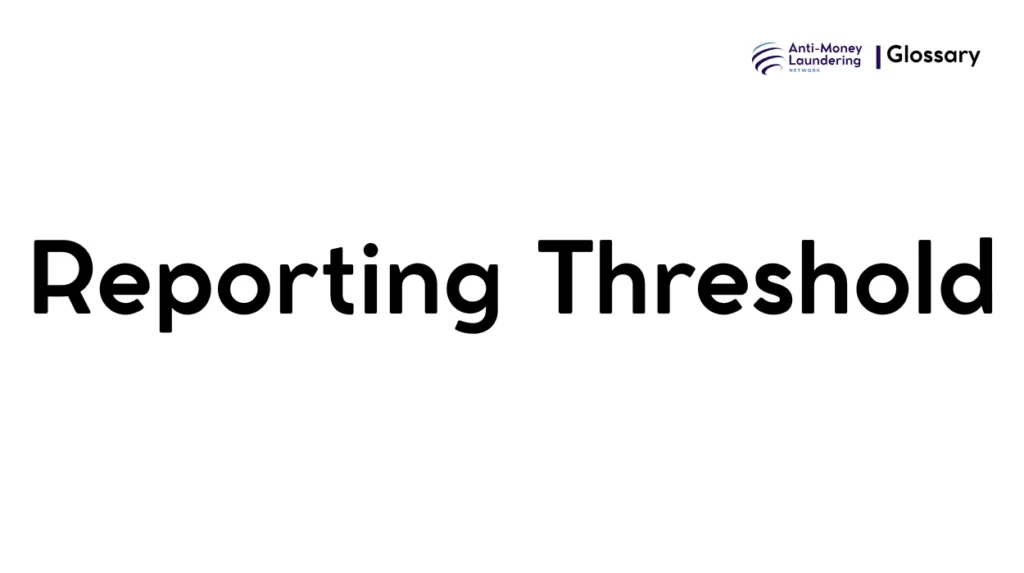Understanding the Reporting Threshold is essential for compliance officers and financial institutions in enforcing Anti-Money Laundering (AML) policies. This comprehensive guide explores the concept, regulatory frameworks, practical applications, and challenges surrounding reporting thresholds within AML regimes globally.
Definition
The Reporting Threshold in AML refers to a predefined monetary or activity limit established by regulatory authorities or institutions. When a financial transaction or series of transactions meets or exceeds this threshold, it triggers the obligation for financial institutions to conduct enhanced scrutiny, monitoring, or report the activity to relevant authorities, such as filing a Suspicious Activity Report (SAR) or Currency Transaction Report (CTR).
Purpose and Regulatory Basis
Role in AML
Reporting thresholds are pivotal in helping institutions balance efficient transaction monitoring with regulatory compliance. They serve as triggers to identify transactions potentially associated with money laundering or terrorist financing, enabling timely investigations and regulatory reporting.
Why It Matters
Thresholds help standardize detection and reporting across institutions, focusing resources on higher-risk activities. They also assist in managing operational workload by prioritizing transactions that warrant further review.
Key Regulations
- Financial Action Task Force (FATF) guidelines encourage risk-based application of thresholds aligned with jurisdictional contexts.
- USA PATRIOT Act mandates reporting of cash transactions exceeding $10,000 and suspicious activities.
- European Union AML Directives (AMLD) require member states to set thresholds, notably for cash deposits and cross-border transfers, to enhance transparency and combat illicit finance globally.
When and How it Applies
Reporting thresholds apply in multiple real-world situations:
- Large cash deposits or withdrawals: For example, in the U.S., transactions above $10,000 must be reported.
- Aggregated transactions: Several smaller transactions that cumulatively exceed the threshold within a set period.
- Cross-border wire transfers: Transactions above specific amounts trigger reporting under rules like the FATF Travel Rule.
Financial institutions monitor transactions continuously, escalating those that breach thresholds for further review and potential SAR filing.
Types or Variants of Reporting Thresholds
Transaction Value Thresholds
Set monetary limits (e.g., $10,000) where individual transactions trigger reporting.
Aggregated Activity Thresholds
Monitor cumulative smaller transactions over time that collectively exceed the threshold.
Cross-Border Transfer Thresholds
Specific thresholds apply for international fund transfers to detect illicit cross-border flows.
Risk-Based Threshold Adjustments
Dynamic thresholds tailored by customer risk profile, geography, or product type, enabling proportionate monitoring.
Procedures and Implementation
Financial institutions implement reporting thresholds through:
- Transaction monitoring systems: Automated rules flag transactions exceeding set limits.
- Control frameworks: Policies regulating threshold levels, escalation protocols, and documentation.
- Employee training: Ensuring staff understand threshold triggers, reporting requirements, and red flags.
- Regular review and calibration: Thresholds must be regularly assessed and adjusted based on emerging risks and regulatory updates.
Effective implementation minimizes false positives while promptly identifying suspicious activities.
Impact on Customers/Clients
From a customer perspective, thresholds can:
- Trigger enhanced due diligence (EDD) when transactions exceed limits.
- Lead to temporary delays or requests for additional information to comply with AML controls.
- Impose limitations or reporting of cash or wire transfers.
Institutions must balance compliance with customer rights, maintaining transparent communication to avoid unnecessary friction.
Duration, Review, and Resolution
- Duration: Reporting obligations are typically triggered immediately upon threshold breach.
- Review Process: Compliance teams analyze flagged transactions within defined timeframes (e.g., 30 days for SARs in the U.S.).
- Ongoing Obligations: Institutions maintain records and may be required to update reports if new information arises.
- Resolution: Reports filed with authorities conclude the immediate obligation but may initiate investigations.
Reporting and Compliance Duties
Institutions must:
- Accurately identify transactions meeting or exceeding thresholds.
- File required reports (SARs, CTRs) promptly and accurately, respecting statutory deadlines.
- Maintain robust audit trails of monitoring and reporting activities.
- Train and supervise staff on AML obligations.
- Comply with sanctions, Know Your Customer (KYC), and ongoing monitoring requirements.
Penalties for failures include fines, enforcement actions, and reputational damage.
Related AML Terms
- Suspicious Activity Report (SAR): A report filed when transactions breach thresholds and raise suspicions.
- Structuring (Smurfing): Deliberate splitting of transactions below thresholds to evade detection.
- Know Your Customer (KYC): Processes to verify customer identities, supporting threshold-based monitoring.
- Enhanced Due Diligence (EDD): Additional scrutiny triggered by threshold breaches or risk factors.
These concepts are interlinked with reporting thresholds as part of a comprehensive AML strategy.
Challenges and Best Practices
Challenges
- Structuring: Criminals evade detection by breaking transactions into smaller amounts below thresholds.
- False Positives: Excessive alerts can overwhelm compliance teams.
- Regulatory Variation: Different jurisdictions have varying thresholds and reporting requirements.
Best Practices
- Implement dynamic, risk-based thresholds that adjust based on customer profiles and transaction patterns.
- Leverage AI and machine learning to detect anomalies beyond fixed thresholds.
- Regularly update thresholds to reflect changes in regulatory landscapes and criminal methodologies.
- Provide continuous staff training and foster a strong compliance culture.
Recent Developments
- Integration of Artificial Intelligence (AI) and Machine Learning (ML) enhances transaction monitoring beyond static thresholds.
- Regulatory trends emphasize risk-based approaches, encouraging institutions to tailor thresholds dynamically.
- Growing focus on cross-border reporting and alignment with international standards like FATF.
- Implementation of automated reporting platforms streamlines compliance and reduces human error.
These trends facilitate more effective AML controls in a complex financial environment.
Reporting thresholds are fundamental to AML compliance, acting as critical flags that trigger scrutiny and regulatory reports. They balance operational efficiency with legal obligations, helping institutions detect and prevent money laundering effectively. Compliance officers must ensure thresholds are strategically set, regularly reviewed, and integrated within a robust risk-based AML framework to safeguard financial systems and uphold regulatory standards.

